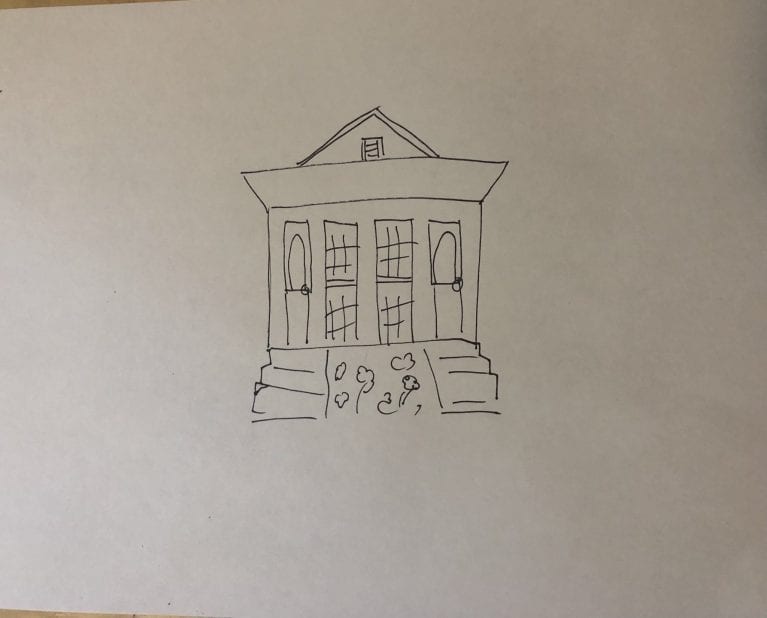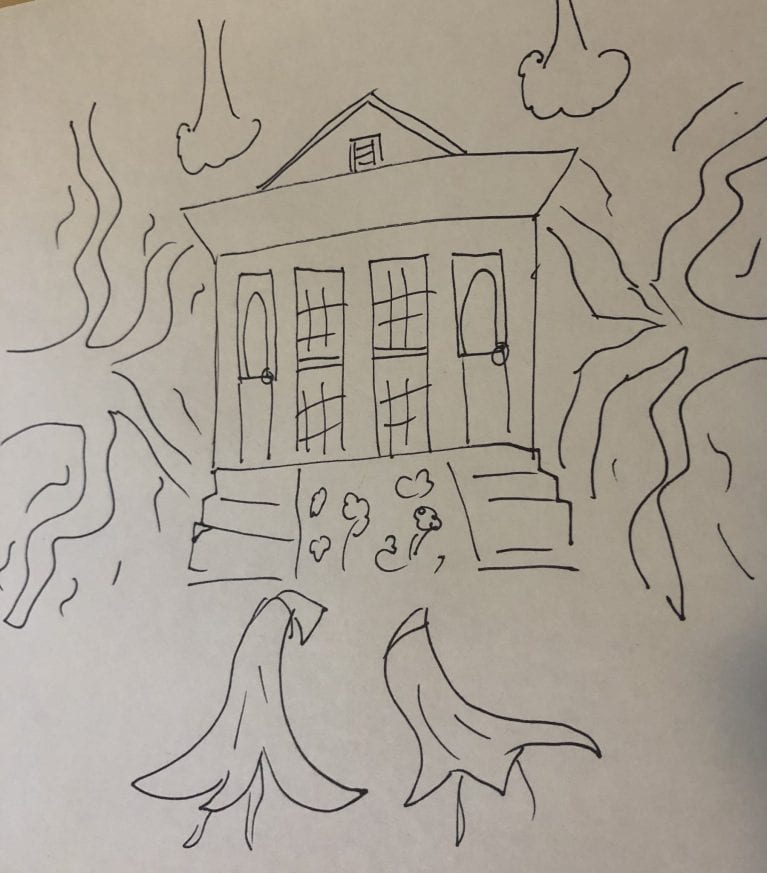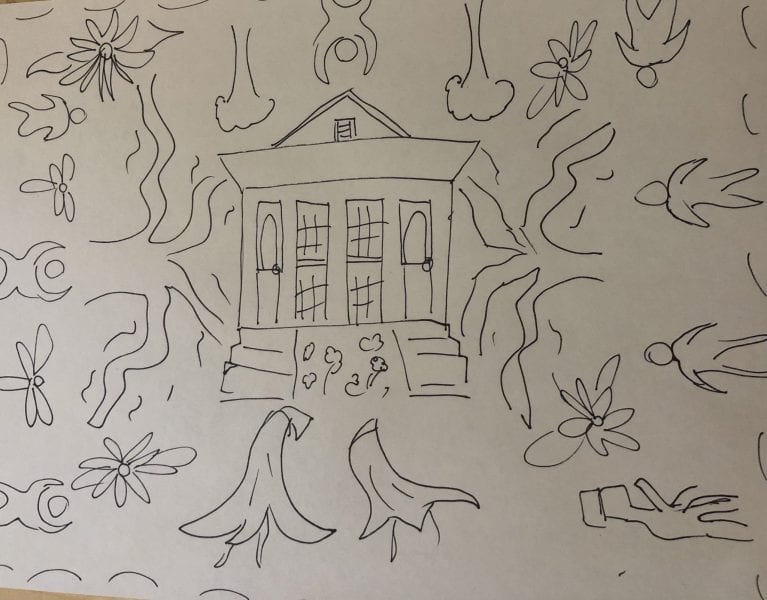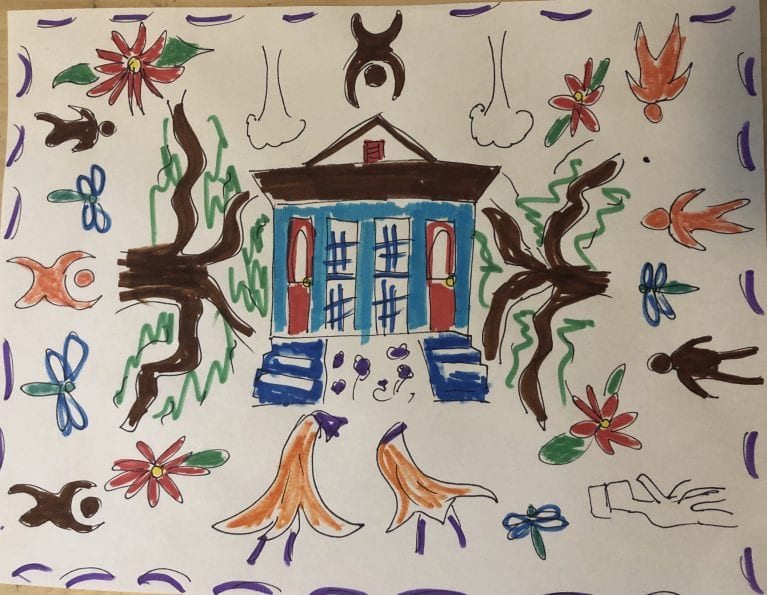Create an artwork inspired by your neighborhood in this week’s O-riginal Art Activity.
Download Activity
Noamy Sechooler, Home is Sacred, Second Line for Reparations and Housing Rights/Solidarity, Oil on canvas
Supplies
Paper, Markers, Pencil
Instructions
Step 1: Look at Noamy Sechooler’s artwork, Home is Sacred, Second Line for Reparations and Housing Rights/Solidarity. What do you notice about the artwork? What do you notice about the position of the houses? What else is depicted in the artwork? Does the arrangement of the subjects create a pattern?
Step 2: Are the houses in your neighborhood similar or different than the ones in the artwork? Do you live in a shotgun house, an apartment complex or a different type of house entirely? Use a pencil to draw your house and other houses or buildings in your neighborhood in the center of your paper.
Step 3: What else is in your neighborhood? Are there trees, plants or animals that live in your neighborhood? Draw these next to the houses.
Step 4: Who else lives in your neighborhood? Use a pencil to draw yourself, family, friends and neighbors on the outer edge of the paper.
Step 5: Use markers to color in your drawing.
Vocabulary
Pattern – a repetition of specific visual elements in art
Repetition – the use of two or more similar elements within a composition. The arrangement of a repeated shape or form creates a pattern




SEE NOAMY SECHOOLER’S HOME IS SACRED, SECOND LINE FOR REPARATIONS AND HOUSING RIGHTS/SOLIDARITY IN LOUISIANA CONTEMPORARY, PRESENTED BY THE HELIS FOUNDATION AT THE OGDEN MUSEUM.
CHECK OUT OGDENMUSEUMONLINE FOR MORE RESOURCES!
QUESTIONS? EMAIL EDUCATION@OGDENMUSEUM.ORG.
________________________________________________________________________
Actividad artística O-riginal: Dibujo del vecindario Inspirado por Noamy Sechooler
Crea una obra de arte inspirada en tu vecindario en la actividad artística O-riginal de esta semana.
Descargar Actividad
Noamy Sechooler, Home is Sacred, Second Line for Reparations and Housing Rights/Solidarity, Oil on canvas | Noamy Sechooler, El Hogar es Sagrado, Segunda Línea de Reparación y Derecho a la Vivienda/Solidaridad , óleo sobre lienzo
Materiales
Papel, marcadores, lápiz
Instrucciones
Paso 1: Observa la obra de arte de Noamy Sechooler, El Hogar es Sagrado, Segunda Línea de Reparación y Derecho a la Vivienda/ Solidaridad. ¿Qué notas sobre la obra de arte? ¿Qué notas sobre la posición de las casas? ¿Qué más se representa en la obra de arte? ¿La disposición de los sujetos crea un patrón?
Paso 2: ¿Las casas de tu vecindario son similares o diferentes a las de la obra de arte? ¿Vives en una casa rectangular estrecha (shotgun house), un complejo de apartamentos o un tipo de casa completamente diferente? Utiliza un lápiz para dibujar tu casa y otras casas o edificios en tu vecindario en el centro del papel.
Paso 3: ¿Qué más hay en tu vecindario? ¿Hay árboles, plantas o animales que vivan en tu vecindario? Dibujalos al lado de las casas.
Paso 4: ¿Quién más vive en tu vecindario? Utiliza un lápiz para dibujarte a ti mismo, a tu familia, amigos y vecinos en el borde exterior del papel.
Paso 5: Utiliza marcadores para colorear tu dibujo.
Vocabulario
Patrón: una repetición de elementos visuales específicos en el arte.
Repetición: el uso de dos o más elementos similares dentro de una composición. La disposición de una forma repetida crea un patrón.




VE MÁS DE EL HOGAR ES SAGRADO, SEGUNDA LÍNEA DE REPARACIÓN Y DERECHO A LA VIVIENDA/SOLIDARIDAD DE NOAMY SECHOOLER EN LUISIANA CONTEMPORÁNEA, PRESENTADA POR LA FUNDACIÓN HELIS EN EL MUSEO OGDEN.
¡VISITA OGDEN MUSEUM ONLINE PARA MÁS RECURSOS
¿PREGUNTAS? ENVÍA UN EMAIL A EDUCATION@OGDENMUSEUM.ORG
